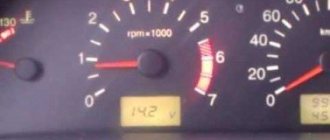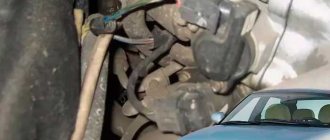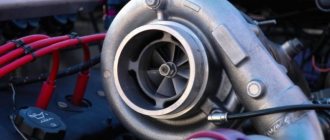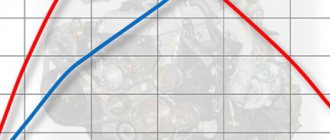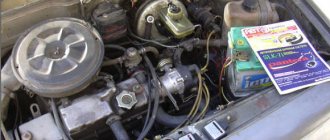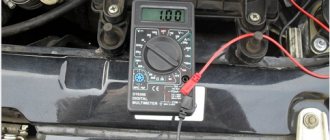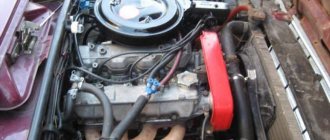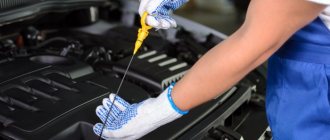Gasoline consumption by the engine begins to worry car owners most often in winter, because it is with the advent of frost that the amount of money given at gas stations increases. Wanting to optimize their budget, drivers begin to search for the causes of the situation and are certainly faced with the question of fuel consumption by the engine at idle per hour.
Next, we will talk about the factors influencing the amount of gasoline burned by the engine, and about ways to independently measure the energy consumption of the power unit while the car is parked. Readers will also be given tips on optimizing fuel consumption.
What affects fuel consumption
Unfortunately, manufacturers do not indicate in the technical documentation for cars any information related to gasoline consumption during engine idling. The only thing you can still try to find in the specifications is the amount of fuel consumption by the engine of a particular series. This situation is explained by the fact that consumption figures depend not only on the engine model, but also on many variable factors:
- Ambient temperatures. In the winter months, you have to spend more fuel to warm up the engine: the lower the air temperature, the higher the speed required to start the engine. Also, if the driver actively uses the air conditioner while the car is parked, gasoline consumption will increase at other times of the year.
- Number of additional electricity consumers. While the vehicle is parked, most of the gasoline is spent on maintaining the operation of the generator and air conditioning: electric compressors rotate thanks to the internal combustion engine. Turning on the headlights, sound system and climate control can increase fuel consumption at idle speed by 7-8 times.
- Technical condition of the engine. The health of the engine affects the amount of gasoline consumed by the car, both while driving and while parked. The better the technical condition of the car, the less fuel is burned.
- Engine volume. Perhaps many readers would consider this factor to be the main one, but, oddly enough, when the engine is idling, the same climate control consumes more fuel than the power unit itself. While the vehicle is at rest, the engine consumes gasoline only for the sake of its own rotation, the energy consumption of which does not depend in any way on the volume of the engine. On the other hand, if an additional load is placed on the engine in the form of an air conditioner, then the owners of large rather than small cars will benefit: the amount of energy required is directly proportional to the concentration of the air-fuel mixture, and it is much easier for an engine with a large volume to rotate the compressor at idle speed.
Factors affecting energy consumption during idling also include the quality of gasoline. If, for example, instead of the recommended AI-95 you use AI-92, then fuel consumption will increase by about 20%: the exact figures depend on the quality of the fuel.
Myths about fuel consumption
There are a large number of myths circulating among car enthusiasts about car fuel consumption. Some of these legends are cultivated by car manufacturers. Below we will look at the most popular myths:
- Coasting reduces consumption
. This is only partly true. Indeed, with a sharp release of gas at a specific point in time, the fuel supply is reduced. This is done to stabilize engine operation. But, with constant idling, fuel consumption is not much less. At the same time, do not forget that in the future you will need to pick up speed, which decreases when coasting, this leads to an increase in fuel consumption. Accordingly, all savings are eliminated. The only option for using coasting is to pre-reduce speed when stopping or before turning; - In traffic jams you need to turn off the engine
. Supposedly this saves fuel. This myth appeared simultaneously with the start-stop function in modern cars. Manufacturers needed to sell this new product to drivers. In fact, it makes sense to turn off the car when parked for more than 10 minutes. If you turn off the engine every time you stop, the consumption will only increase. When starting the engine, some of the fuel simply flies out into the exhaust pipe without any effect. This also increases the wear rate of power unit parts. Therefore, do not turn off the car when stopping at a traffic light; - Installing a spoiler reduces consumption
. This statement is true exactly the opposite. In fact, the wing is designed to press the car to the road. This happens due to an increase in resistance to oncoming flow. Accordingly, the higher the angle of attack and downforce, the more fuel consumption increases. This myth comes from motorsport, where a wing really reduces fuel consumption, but there the spoiler or wing is selected individually, and the car is necessarily blown in a wind tunnel; - The higher the gear, the lower the consumption
. In fact, this is not entirely true. The optimal engine operating mode from the point of view of economy is 70-75% of maximum speed. For example, at a maximum speed of 4000, the most economical will be to maintain 3000-3100 rpm. In a high gear, the engine runs at lower speeds and consumption increases.
Conclusion
. Now fuel prices are regularly rising. And even the most careless drivers begin to think about the fuel consumption of their car and opportunities for savings. Therefore, many people wonder what the consumption of gasoline and diesel is at idle per hour. This is especially interesting for people in big cities who are forced to stand in traffic jams for a long time. It is important for them to know how much fuel is consumed under such conditions. This allows you to avoid a completely dry tank away from the gas station.
How to measure fuel consumption per hour at idle speed
To determine the amount of gasoline consumed by an engine at idle, you need to find out by how many milliliters the amount of fuel in the tank of a stationary car decreases over a selected period of time. To take measurements, the owner of a car with a carburetor engine will need:
- Fill the canister with the pre-measured amount of gasoline.
- To connect this canister to the engine, you will have to replace the fuel line, which goes to the internal combustion engine pump, with a hose lowered into the canister.
- Start the vehicle, after first making several “pumps” with the frog of the fuel pump.
- Leave the car with the engine idling for 60 minutes.
- Determine how much gasoline disappeared from the canister during the hour of the experiment.
If desired, the car can be made to warm up not for 60 minutes, but, for example, for 20. In such a case, the volume of fuel consumed during the test will need to be multiplied by 3 - this coefficient is found by the formula: K = 60 / X, where X is the time of the experiment (in minutes).
The described method is not suitable for cars with injection engines. Since in these cars the fuel pump is usually located in the gas tank, connecting a canister will make starting the engine simply impossible. To solve the problem you should:
- Fill the tank until full.
- Leave the car to warm up for 1 hour.
- Refill the gas tank.
The amount of fuel that will fit into the tank after an hour of idling the engine will be the desired indicator.
Types of fuel consumption on the car's on-board computer
Fuel consumption is divided into three types: instantaneous, average and idling fuel consumption.
Instantaneous fuel consumption represents the vehicle's fuel consumption in real time. When the car is in motion, the computer displays fuel consumption in the form “L/100 km”, where “L” is fuel consumption in liters.
Average fuel consumption is the fuel consumption of a vehicle over a certain period of time. Unit of measurement: “L/100 km”, where “L” is fuel consumption in liters.
Idle fuel consumption is the vehicle's fuel consumption while idling, usually measured in hours. In some vehicles, when stopped and the engine is idling, fuel consumption begins to be displayed as “L/H”, where “L” is fuel consumption in liters and “H” is 1 hour.
How much does autostart consume?
According to statistics, most cars equipped with a gasoline engine with a displacement of up to 2.0 liters consume 1,000 milliliters of fuel per hour when warming up in the winter months. In the warm season, gasoline consumption decreases to 800 ml. It is worth noting that the type of gearbox does not affect these indicators in any way.
So, to find out what the fuel consumption is when using the autostart function, you will need to try the following formulas:
- In winter - 1000 (ml) / 60 (min) x t.
- In summer - 800 (ml) / 60 (min) x t.
In these formulas, “t” denotes the time for automatic warming up of the engine. Since many alarms are configured by default to start a 10-minute warm-up, in the case of a car with a 2-liter engine, the gasoline consumption by autostart will be approximately equal to:
- In winter - 1000 (ml) / 60 (min) x 10 (min) = 167 (ml/h).
- In summer - 800 (ml) / 60 (min) x 10 (min) = 133 (ml/h).
It turns out that in winter, autostart burns 0.17 liters of fuel per hour. It should be added that when using the interior heating system, this figure can increase to 1.5 l/h. To obtain accurate data, you will need to independently measure gasoline consumption at idle, and not rely on the statistics above.
How much fuel is consumed when idling?
Many people ask this question, but it’s often a waste of time to go to Google for answers, or even more so to measure it yourself. Therefore, just for such a case, I am publishing this post.
Some believe that when a gasoline engine is idling, fuel consumption increases above average levels, due to the fact that the on-board computer in the “instantaneous consumption” item shows the maximum value on the scale. There are also myths that, on the contrary, when parked with the engine running, the car supposedly does not eat anything. Moreover, I have even met victims of this myth.
I stopped, I remember, in the parking lot, there was a started-up Kia nearby, in which a lady was sitting, hiding from the heat. He went out on business and periodically returned to the car to take something and put something down. And the Kia is still running. And so for about 40 minutes, and how long she stood before that is unknown. A thought flashed through my mind: “Oh my god, this rich woman is sitting there, burning gas.” But when I approached my car for the last time to move on, the lady was loudly lamenting on the phone to her boyfriend or husband that she had somehow run out of gas, despite the fact that she was standing still.
In fact, everything is simple, in order to roughly understand how much fuel your car consumes per hour at idle, you need to divide its average consumption per 100 km by 10.
For example, if your jalopy’s appetite is 10 liters per hundred, then at idle it will consume 1 liter per hour. But here you need to take into account that these figures are averaged, in addition, with the air conditioner, headlights and radio turned on, fuel consumption increases.
The same goes for diesel engines. There is an opinion that a diesel engine consumes practically nothing at idle, until recently I thought so myself, but this is not so. The same formula applies to it, and due to its overall efficiency, the figure will be lower.
And yes, when starting the engine and warming it up in winter, consumption also increases. Although I hardly discovered America to anyone here.
How to reduce fuel consumption
To reduce the amount of fuel consumed during idling, the car owner is recommended to:
- warm up the engine for no more than 5 minutes - until the “warm-up” speed drops;
- do not turn on the headlights when warming up, reduce the intensity of the interior heating system to a minimum;
- use heated windows and mirrors only when absolutely necessary;
- insulate the engine and install an autonomous heating system - as a result, the likelihood of engine freezing will be reduced to a minimum.
As soon as the engine speed drops, the driver should start driving, finishing the warm-up while driving.
Video.
The issue of fuel consumption is extremely popular among ordinary motorists, and the main reason for this is the constant increase in fuel prices. Moreover, if earlier people were interested in how much a car “eats” while driving, today the topic of fuel consumption at idle .
Many people believe that at idle speed the engine consumes virtually no fuel, but this is far from true and, as they say, miracles do not happen. In this article I will try to clarify this issue and answer as fully as possible the question of how much fuel a car consumes at idle , in addition, you will learn what affects this and how to reduce fuel consumption at idle.
In the summer, by and large, fuel consumption at idle will be minimal, since warming up as such is not needed and, as a rule, does not work when the car is idling. Although, on the other hand, if the summer is hot and the car has air conditioning, then situations are quite possible when the car is standing still and the engine is idling. I note that you have to burn fuel while standing still not only during warming up; there are quite a few other situations. For example, traffic jams, traffic lights, as well as a situation similar to the summer version, when in winter, in the bitter cold, you need to warm up, the engine is also started or not turned off so that the stove can warm up the cold interior.
Trivial reasons for fuel consumption
There was a case, a friend of mine also had an increase in consumption on our VAZ, he began to eat 1 - 1.5 liters more. Everything has been checked and everything is in order, both the ignition system, fuel supply and air filtration. But the car consumes more and that’s it. It turned out to be simple. The car's rear brake pads were recently changed and the handbrake was tightened almost to the limit, so that with one click up, the car could not be moved. We went to the service station again, loosened the handbrake a little so that with 3-4 clicks the car would lock into place.
And everything returned to its previous state, it turns out that the rear pads did not allow the car to roll, I had to rev the gas all the time, which resulted in increased fuel consumption. So check the braking system after replacing the brake pads.
This is probably all, these are the main reasons. If anyone has anything to add, write in the comments below.
If your car consumes much more fuel than set by the manufacturer, this may be a sign of a breakdown or errors in driving the car. The article discusses 10 reasons that can lead to increased fuel consumption.
The reasons for increased fuel consumption in a car can be divided into operational and dependent on the technical condition.
Operational causes of excessive fuel consumption include:
1. car class and engine size. You should not expect low fuel consumption from a luxury car. However, there is a slight paradox: the fuel consumption of a car with a large engine capacity is lower than that of a car of the same class, but with a smaller engine capacity. This is due to the fact that a car with a larger engine capacity requires less load to operate at the same speed.
2. driving style. Excessive fuel consumption occurs during sudden acceleration and braking, and therefore if you like to start with what is called slipping or often perform the acceleration and braking procedure, then be prepared for excessive fuel consumption. Therefore, to save fuel, use a smooth driving style. In addition, it will protect you from accidents and fines.
3. climatic conditions and terrain. Fuel consumption depends on the air temperature, for example, in winter the consumption increases by at least 10%. The terrain also affects consumption. This is due to the fact that the car's engine is under greater load when climbing.
4. fuel quality. High-octane gasoline A-95 releases more energy than A-92, and, accordingly, to maintain the same speed, less fuel with a higher octane number will be required. Here you just need to remember that not all engines are capable of running on high-octane gasoline without compromising their technical condition. It is better to refuel your car at proven gas stations, because low-quality gasoline leads not only to increased fuel consumption, but also to increased engine wear.
Reasons for increased fuel consumption in a car
, depending on the technical condition:
5. faulty lambda probe. This malfunction causes the EFI to supply more fuel than necessary. You can find out about a malfunction of the oxygen sensor through computer diagnostics or by measuring CO.
6. spark plugs. If the spark plugs are faulty, the fuel may not burn completely or not burn at all (when the engine “trips”). This results in a large amount of fuel being required to achieve a certain power. The ignition timing can also have an effect. If the advance angle is set incorrectly, the engine may significantly lose its power, and, consequently, fuel consumption may increase.
7. filters (air, fuel, oil). Clogged filters lead to increased load on the engine.
8. high voltage wires. If they are faulty, incomplete combustion of the combustible mixture also occurs, which leads to a drop in engine power.
9. idle speed. If the adjustment is incorrect and the speed is high, excessive fuel consumption occurs, especially in urban mode.
10. compression in combustion chambers. If the compression does not meet the required parameters, the engine will consume more fuel to achieve the required power.
Additional fuel consumers in the car
Also, increased fuel consumption can be influenced by the gearbox. There is no laboratory confirmation that automatic transmission causes increased fuel consumption (a faulty automatic transmission has been proven to lead to higher fuel consumption), however, some car owners claim a 10% increased fuel consumption in cars with Automatic transmission. The same applies to the injection system. Injection systems consume significantly less fuel than carburetor cars. Remember that fuel consumption is also affected by electricity consumers. Power steering, car radio, air conditioning, etc. insignificantly, but they “take away” power from the engine, thereby increasing fuel consumption. The power take-off is especially noticeable when driving a small car with the air conditioning on uphill.
The article lists the main reasons for increased fuel consumption in a car, but to find out exactly why your car is overconsuming fuel, you need to diagnose the car. Very often, the cost of car repairs to reduce fuel consumption turns out to be significantly higher than the cost of excessively burned fuel, so think about whether excessive fuel consumption by your car is so critical for you.
How long can you idle without damaging your car? How dangerous is this for a car?
Every driver has encountered the need to use idle speed. Without it, it is impossible to start moving. In addition, it is used to warm up the car. Idling is also used in traffic jams. But sometimes, traffic jams drag on for many hours. So doubts arise about the safety of prolonged idle time. The Proavtomasla.ru portal has sorted out this difficult issue.
What do drivers say?
In this matter, motorists are divided into two groups. Some say that idling does not harm the engine in any way. Well, others, on the contrary, believe that current cars are created with the expectation of constant load, and not idle time. Allegedly, this way the engine becomes dirty and quickly fails. And which of them is right?
What is idle speed?
Idling is the operation of a car engine without load. That is, when the car works, but does not go anywhere and stands still. The engine itself maintains minimum speed and does not stall.
Previously, idle control was a very simple device. On old-style carburetor cars, stable speeds were achieved by pressing the gas pedal. But on modern cars, everything is done by a computer. On such cars, the idle speed needs to be adjusted or additional mechanisms installed. One of these devices is a special sensor that engineers introduced. If it is not there, the car will immediately stall or begin to pick up high speeds. And at the moment, there are no other methods.
Automakers, of course, when releasing new models take into account the likelihood of prolonged idling. But it is impossible to calculate the exact time. And sometimes, traffic jams get so long that drivers have to sleep with the engine running.
How does idling affect the engine?
A friend of mine advises not to worry about the condition of the power unit. Prolonged downtime is not as harmful as some drivers think. According to them, in such conditions the engine does not have enough oil.
In general, oil starvation can occur. But this only happens when there is a malfunction. Namely, errors and technical miscalculations. Engine contamination does not justify the operation of the oil pump. As you know, it depends on the number of revolutions. And to lubricate the engine at idle, only a minimum pressure in the system is required.

